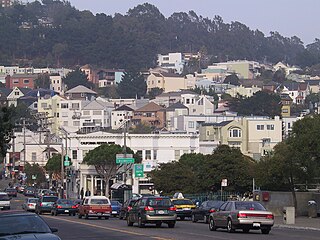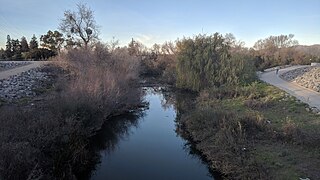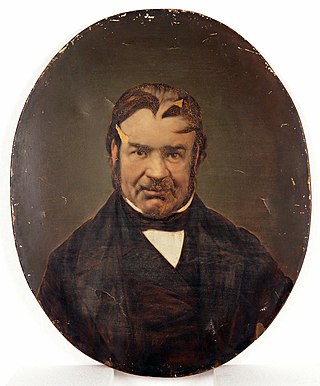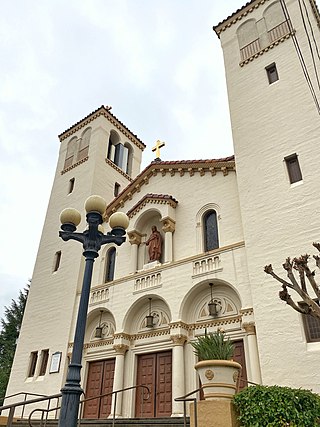
Campbell is a city in Santa Clara County, California, in the San Francisco Bay Area. As of the 2020 U.S. Census, Campbell's population is 43,959. Campbell is home to the Pruneyard Shopping Center, a sprawling open-air retail complex which was involved in a famous U.S. Supreme Court case that established the extent of the right to free speech in California.

Edgewater is a lakefront community area on the North Side of the city of Chicago, Illinois six miles north of the Loop. The most recently established of the city's 77 official community areas, Edgewater is bounded by Foster Avenue on the south, Devon Avenue on the north, Ravenswood Avenue on the west, and Lake Michigan on the east. Edgewater contains several beaches for residents to enjoy. Chicago's largest park, Lincoln Park, stretches south from Edgewater for seven miles along the waterfront, almost to downtown. Until 1980, Edgewater was part of Uptown, and historically it constituted the northeastern corner of Lake View Township, an independent suburb annexed by the city of Chicago in 1889. Today, Uptown is to Edgewater's south, Lincoln Square to its west, West Ridge to its northwest and Rogers Park to its north.

State Route 87, known as the Guadalupe Freeway or referred to by the locals as Highway 87, is a north–south state highway in San Jose, California, United States. Before being upgraded to a freeway, it was Guadalupe Parkway.

Glen Park is a residential neighborhood in San Francisco, California, located south of Twin Peaks and adjacent to Glen Canyon Park.

The main segment of the Los Gatos Creek Trail is a 9.7-mile (15.6 km) pedestrian and bicycle trail that runs through western Santa Clara County in California. It runs from Lexington Reservoir in Los Gatos, California through Campbell, California to Meridian Avenue in San Jose, California alongside Los Gatos Creek.

The Alameda is a historic district of Central San Jose, California, west of Downtown San Jose. The district is centered on an alameda, a historic portion of El Camino Real connecting Downtown San Jose to Mission Santa Clara de Asís, and includes the smaller, surrounding neighborhoods to the north and east, like College Park and St. Leo's.

Vasona Lake County Park is a park located in Los Gatos, California and part of the Santa Clara County Parks system. Vasona Park surrounds the Vasona Reservoir. Adjacent to the park are the Billy Jones Wildcat Railroad, a ridable miniature railway, and the W.E. "Bill" Mason Carousel at the Oak Meadow Park.

The Peninsular Railway was an interurban electrified railway in the U.S. State of California in the United States of America. It served the area between San Jose, Los Gatos, and Palo Alto, comprising much of what is today known as "Silicon Valley". For much of its existence it was a subsidiary of the Southern Pacific Railroad.

The Los Gatos Creek runs 24 miles (39 km) in California through Santa Clara Valley Water District's Guadalupe Watershed from the Santa Cruz Mountains northward through the Santa Clara Valley until its confluence with the Guadalupe River in downtown San Jose. The Guadalupe River then continues onward into San Francisco Bay.
Columbus, the state capital and Ohio's largest city, has numerous neighborhoods within its city limits. Neighborhood names and boundaries are not officially defined. They may vary or change from time to time due to demographic and economic variables.

The Guadalupe River Trail is an 11-mile (18 km) pedestrian and bicycle path in the city of San Jose, California. The path runs along the banks of the Guadalupe River. The trail is currently composed of two discontinuous segments: a shorter "upper" segment in the Almaden Valley neighborhood of San Jose and a longer "lower" segment through Downtown San Jose to Alviso. This trail is heavily used for both recreation and commuting, as it provides direct access to Downtown San Jose from many of the outlying neighborhoods. The trail is paved.

Rancho Los Coches was a 2,219-acre (8.98 km2) Mexican land grant in present-day Santa Clara County, California given in 1844 by Governor Manuel Micheltorena to Roberto Balemino, an Indian. The name means Ranch of the Pigs. The grant was located on the west bank of Los Gatos Creek, south of San Jose, near the present-day Burbank. The historic Roberto Adobe & Suñol House is located within the former rancho.

San Tomas Aquinas Creek, known locally as San Tomas Aquino Creek, is a 16.5-mile-long (26.6 km) stream that heads on El Sereno mountain in El Sereno Open Space Preserve in Saratoga, California in Santa Clara County, California, United States. It flows north through the cities of Saratoga, Monte Sereno, Los Gatos, Campbell, Santa Clara and San Jose before its confluence with the Guadalupe Slough in south San Francisco Bay.

The Three Creeks Trail is a 0.9-mile (1.4 km) pedestrian and bicycle trail that runs through the Willow Glen neighborhood in San Jose, California, from Los Gatos Creek by Lonus Street to the Guadalupe River. It directly connects to the northern segment of the Los Gatos Creek Trail and indirectly connects to several other trails.
Hispanic and Latino Americans in San Francisco form 15.1% of the population. The city's population includes 121,744 Hispanics or Latinos of any race. The principal Hispanic groups in the city were those of Mexican (7.4%), Salvadoran (2.0%), Nicaraguan (0.9%), Guatemalan (0.8%), and Puerto Rican (0.5%) ancestry. The Hispanic population is most heavily concentrated in the Mission District, Tenderloin District, and Excelsior District.

Communications Hill is a neighborhood located in the San Juan Bautista Hills of San Jose, California.

Don Antonio María Suñol was a Spanish-born Californio businessman, ranchero, and politician. He served two terms as Alcalde of San José (mayor) and was one of the largest landowners in the Bay Area. He is the namesake of the town of Sunol and the founder of Willow Glen, an affluent neighborhood of San Jose.

Washington-Guadalupe is a neighborhood of central San Jose, California, located just south of Downtown San Jose. It is one of San Jose's most historic Chicano/Mexican-American districts. The area is a designated historic conservation district. The portion of Willow Street that passes through the district makes up the Calle Willow business district, made up primarily of Spanish-speaking businesses.





























